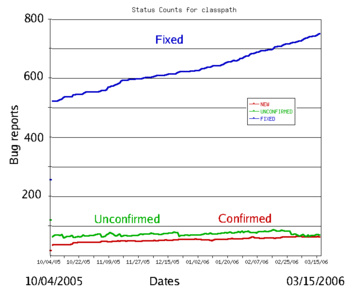Prevention

Preventing bugs as early as possible in the software development process is a target of investment and innovation. [9] [10]
Language support
Newer programming languages tend to be designed to prevent common bugs based on vulnerabilities of existing languages. Lessons learned from older languages such as BASIC and C are used to inform the design of later languages such as C# and Rust.
Languages may include features such as a static type system, restricted namespaces and modular programming. For example, for a typed, compiled language (like C):
float num = "THREE AND A BIT";
is syntactically correct, but fails type checking since the right side, a string, cannot be assigned to a float variable. Compilation fails – forcing this defect to be fixed before development progress can resume. With an interpreted language, an failure would not occur until later at runtime.
Some languages exclude features that easily lead to bugs, at the expense of slower performance – the principle being that, it is usually better to write simpler, slower correct code than complicated, buggy code. For example, the Java does not support pointer arithmetic which is generally fast, but is considered dangerous; relatively easy to cause a major bug.
Some languages include features that add runtime overhead in order to prevent some bugs. For example, many languages include runtime bounds checking and a way to handle out-of-bounds conditions instead of crashing.
A compiled language allows for detecting some typos (such as a misspelled identifier) before runtime which is earlier in the software development process than for an interpreted language.
Techniques
Programming techniques such as programming style and defensive programming are intended to prevent typos.
For example, a bug may be caused by a relatively minor, typographical error (typo) in the code. For example, this code executes function foo only if conditionis true.
if (condition) foo();
But this code always executes foo:
if (condition); foo();
A convention that tends to prevent this particular issue is to require braces for a block even if it has just one line.
if (condition) { foo(); }Enforcement of conventions may be manual (i.e. via code review) or via automated tools.
Specification
Some contend that writing a program specification which states the behavior of a program, can prevent bugs.
Some contend that formal specifications are impractical for anything but the shortest programs, because of problems of combinatorial explosion and indeterminacy.
Software testing
One goal of software testing is to find bugs.
Measurements during testing can provide an estimate of the number of likely bugs remaining. This becomes more reliable the longer a product is tested and developed.[ citation needed ]
Agile practices
Agile software development may involve frequent software releases with relatively small changes. Defects are revealed by user feedback.
With test-driven development (TDD), unit tests are written while writing the production code, and the production code is not considered complete until all tests complete successfully.
Static analysis
Tools for static code analysis help developers by inspecting the program text beyond the compiler's capabilities to spot potential problems. Although in general the problem of finding all programming errors given a specification is not solvable (see halting problem), these tools exploit the fact that human programmers tend to make certain kinds of simple mistakes often when writing software.
Instrumentation
Tools to monitor the performance of the software as it is running, either specifically to find problems such as bottlenecks or to give assurance as to correct working, may be embedded in the code explicitly (perhaps as simple as a statement saying PRINT "I AM HERE"), or provided as tools. It is often a surprise to find where most of the time is taken by a piece of code, and this removal of assumptions might cause the code to be rewritten.
Open source
Open source development allows anyone to examine source code. A school of thought popularized by Eric S. Raymond as Linus's law says that popular open-source software has more chance of having few or no bugs than other software, because "given enough eyeballs, all bugs are shallow". [11] This assertion has been disputed, however: computer security specialist Elias Levy wrote that "it is easy to hide vulnerabilities in complex, little understood and undocumented source code," because, "even if people are reviewing the code, that doesn't mean they're qualified to do so." [12] An example of an open-source software bug was the 2008 OpenSSL vulnerability in Debian.



